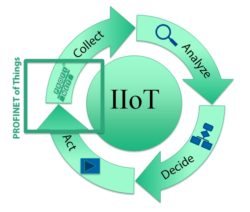The magic in the Industrie 4.0/Industrial Internet of Things meme is the analytics. Mining Big Data in the Cloud reveals where process improvements and cost savings can be found. The whole analytics thing is kind of murky (cloudy? FOG-gy?) for me. I see where PROFINET is good at providing the data (raw data, data quality data, diagnostic data, organized data), but I don’t get the statistics thing. For me, it’s in the category of “Any sufficiently advanced technology is indistinguishable from magic” to quote Arthur C. Clarke.
Because of the analytics part of IIoT there’s a great need for mathematicians and statisticians I’ve heard.  But how can conclusions be drawn if the analyzer does not understand the process? How can he know what happens when the vertical conveyor fails to keep up with the material from the horizontal conveyor in a grain silo? Maybe there’s magic in the numbers, but it seems to me there is no substitute for deep vertical industry knowledge. {Oh, the answer to the conveyor question is that grain piles up and must be manually removed by workers with shovels.) A System Integrator or OEM knows their specialty. In the grain case they know a frequent problem is overheating bearings in the conveyor. So, add a temperature sensor (a very IIoT thing to do) and prevent the problem with proactive maintenance. This grain silo example is actually a real example from several years ago.
But how can conclusions be drawn if the analyzer does not understand the process? How can he know what happens when the vertical conveyor fails to keep up with the material from the horizontal conveyor in a grain silo? Maybe there’s magic in the numbers, but it seems to me there is no substitute for deep vertical industry knowledge. {Oh, the answer to the conveyor question is that grain piles up and must be manually removed by workers with shovels.) A System Integrator or OEM knows their specialty. In the grain case they know a frequent problem is overheating bearings in the conveyor. So, add a temperature sensor (a very IIoT thing to do) and prevent the problem with proactive maintenance. This grain silo example is actually a real example from several years ago.
I think there is a huge opportunity for OEMs and SIs with deep vertical knowledge. They can leverage IIoT, PROFINET, and remote monitoring (and maybe even some magic statistics package) to add value for their customers and income for themselves.
–Carl Henning
